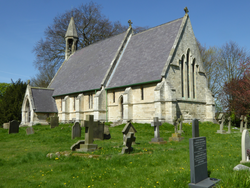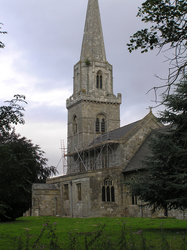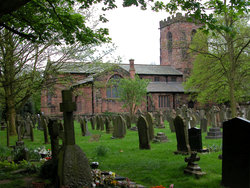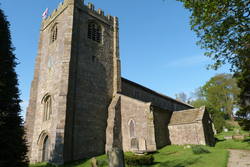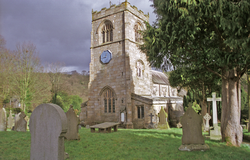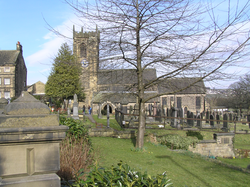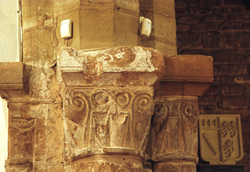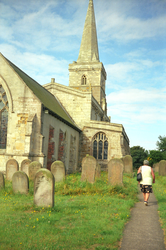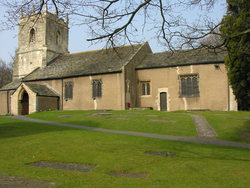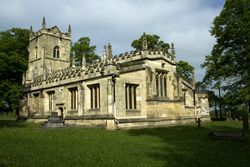
The Corpus of ROMANESQUE SCULPTURE in Britain & Ireland

St Wilfrid (now)
Parish church
South Stainley is a village near Ripon in North Yorkshire. The church has only a one-line entry in Pevsner (1967, 492), who gives the date as 1845. It has a nave with S porch; chancel with vestry, and was rebuilt on a medieval site. In an engraving of the church made before the rebuilding of 1845, there are no obviously 12th-century features (see Site Images). Sir Stephen Glynne did not visit the church.
In 1999, two loose pieces were seen which are relevant to the Corpus: two large half-capitals with waterleaf. At that time they were on the benches in the porch; in 2015 they were inside the church. There is some discussion about other features (for which, see Comments). A large plain cylindrical tub outside in front of the porch was said to be a font. A length of string-course in the chancel has been said to be original, but even if it is, it is unlikely to be twelfth-century.
Parish church
A large church of greyish white limestone with a tall spire about a mile and a half from Selby Abbey. To the NE, the Victorian extension of Selby along Brook Street, with hospital and schools, comes close, and to the SW is Brayton itself. The church has green spaces immediately around it; most of these areas are known to flood seasonally; the churchyard itself has an area that floods quite often. Since the 12th-century parts of the church are unlikely to have much footings, and certainly no damp course, the parts of interest to this Corpus are seen to be suffering worst from efflorescence (rising damp) and algal growth (constant damp), not only externally but on internal walls as well. The decay is accelerating, as comparing the earlier photos with the recent ones may demonstrate. The church comprises W tower, aisled nave, S porch; chancel and N vestry. The unbuttressed tower is largely of 12thc date, up to and including the corbels on the four sides. The chancel arch also remains largely intact except where restored. The S doorway of three orders was reset from its original position when the S aisle was added. The N arcade was cut in the N wall of the Norman nave. The nave and chancel seem unusually spacious, this is perhaps because there is no chancel step but only a step at the sanctuary.
A restoration by J. L. Pearson, c.1877 or so (Borthwick Instituete Fac.1877/3) repaired damage but was not excessively zealous; Pearson probably added the porch, but, as at Riccall, this has added to the problems of damp. Previous work done about 1868 is likely to have been responsible for some of the over-heavy restoration treatment on the chancel arch, such as tinkering with heads, and the bolder label.
Traces of medieval paint remain on S arcade bay 3 (that is, on a surface later than the Romanesque), on 12thc work on the N side of the tower arch, nave face of third order, and on a medallion of the S doorway. Internally, on the W wall of the nave above the tower arch, can be seen the original roof line, and also a rectangular opening, now blocked. There is a similar rectangular opening in the wall above the chancel arch. This too is blocked. The quality of the sculpture is high, the state of preservation generally good inside the church, but worsening on the doorway due to damp from ground water and the lack of a damp course combined with the restricted circulation of air within the porch. To summarise, items of interest here are the S doorway, chancel arch, tower arch, font, and corbels on the tower.
Parish church
St Wilfrid's has a long nave and chancel, continuous inside and out with no chancel arch but the division marked by a step. N and S aisles occupy the five bays of the nave and two bays of the chancel; a short aisleless section of chancel at the E end is raised for the main altar. At the W end is a tower, and a transeptal vestry has been added to the N chancel aisle. The earliest part of the fabric is the remnant of a corbel table high in the N wall of the S aisle. This indicates an early 12thc. aisleless church. In 1334 the Boydell Chapel was added alongside this nave on the S side, and features of this remain in the S windows and some of the glass. In 1525-39 there was a major rebuilding involving the construction of both arcades and aisles, and the W tower. The clerestorey was added in 1833, and remodelled in the major restoration of 1874 by Paley and Austin. The N vestry also dates from this restoration. The font and the corbels in the S aisle are described below.
Parish church
The church of Melling is most striking for its extremely high-floored chancel, ten steps up from the nave, caused by the slope of the land. The church is almost entirely late Perpendicular, except for the W windows of the nave aisle - a plain lancet on the N, a cusped trefoil on the south, and a reset Dec window in the vestry.
In 1823, Whitaker described a 'rich Norman doorway'. However the only evidence of Romanesque masonry on-site is a single voussoir of chevron built into the wall of the mid-19thc vestry.
Parish church
Burnsall is a small village in Wharfedale, North Yorkshire. The church of St Wilfrid is Grade I liisted and lies adjacent to the River Wharfe and its famous five-arched bridge. It is essentially Perpendicular, with W tower, aisled nave and chancel, and was restored in the 1850s. The aisles were added in the second quarter of the 13thc. The church has a good collection of pre-Conquest sculpture, which has recently been arranged in a permanent exhibition (see Coatsworth, Wood and Butler 2005). There are also several pieces remaining from the Romanesque period, including a re-set corbel, a font, a monolithic window-head, parts of four grave slabs, and a stoup.
Parish church
Calverley lies midway between Bradford and Leeds and overlooks the River Aire. Built in local gritstone, the large church of St Wilfrid appears to be mostly late medieval, and was restored 1869-70. It has a chancel with a N vestry and chapel, an aisled nave with a porch, and a W tower. One blocked window in the S wall of the nave shows that there was an earlier aisleless church, although the window head is undateable. Sculpture appears only on numerous grave-slabs found during the 19thc. building works (Ryder 1991; 1993).
Parish church
The church consists of a nave, chancel and W tower with S porch and a 20thc. vestry in the N angle of tower and nave. The building has a somewhat complicated architectural history. The church was rebuilt in the 14thc. using many of the old stones, as can be seen outside on the N wall of the chancel. In 1499 money was left for the construction of a rood loft; the incisions in the impost blocks of the chancel arch may date from this time. Between 1760-63 the nave and tower were largely rebuilt and the windows in both nave and tower replaced with round headed ones. The chancel was rebuilt in 1835. There was a further restoration of the building in 1881 when the nave windows were replaced and the sculptural fragments described below (VI Loose Sculpture) came to light when the floor of the nave was lowered by two feet.
Parish church
A large church with W tower, aisled nave, S chapel and chancel; pantiled porch. Part of the SE corner of the nave is supposed to be early fabric. Steep pitched roofs are marked on the E walls of tower and nave. The fabric is very mixed, often cobbles are used, whatever the date. Box pews remain in the nave; a stone lectern in the chancel. Thick walls at SE corner of nave and part of the S wall of the chancel are considered to be of the 12thc.
The tower arch was perhaps remade from the chancel arch; two remounted corbels are in the wall above the N arcade. The fabric of the tower arch indicates a good quality building, while the corbels are quite simple.
Parish church
The church lies in Cantley, surrounded by modern houses, on a lane between Cantley and Branton, about a mile from the village of Old Cantley and Cantley Hall. It is in Church Lane, within a large wooded graveyard rising up from the surrounding roads. Its orientation is a long way north of east (Ryder 1982). The west tower is of white stone, the walls pebble-dashed except for door and window surrounds, the porch and the buttresses of the east end. Much of the church is EE or Dec. with a Perp. W tower. Restored by Giles Gilbert Scott in the 1850s. N. aisle, interior additions and splendid decorations by Sir Ninian Comper in late 19th century (Pevsner 1967, 156-7). The restorations are listed in Butler (2007). Earlier commentators remark on restorations (Hunter 1828, 81-5) or the need for them (Visitation Return 1877). For further comments on the site itself, see VII, History. The priest’s door is Romanesque.
Parish church
The church lies close to Hickleton Hall and its extensive outbuildings, including lodge, stabling etc, surrounded by trees. The 20th-century lords of the manor, the earls of Halifax, redecorated and refurnished the interior of the church in the Anglo-Catholic tradition. Externally the church is Perpendicular. Owing to subsidence caused by coal mining, a rescue archaeology project and restoration at the church was funded by the National Coal Board in 1982-6; the report of the excavation was never fully published, but the papers are with South Yorkshire Archaeological Services (see Bibliography below). The Romanesque remains are the chancel arch, and some loose stones housed at the time of our visit in the nearby stable buildings of Hickleton Hall. In Doncaster Museum store is at least one item from the excavation at the church, a star-patterned window-head probably from the east window, recorded for CRSBI in December 2001, YW97(35). According to Raine 1873, 186, the dedication in 'modern' times, was St Denis.
